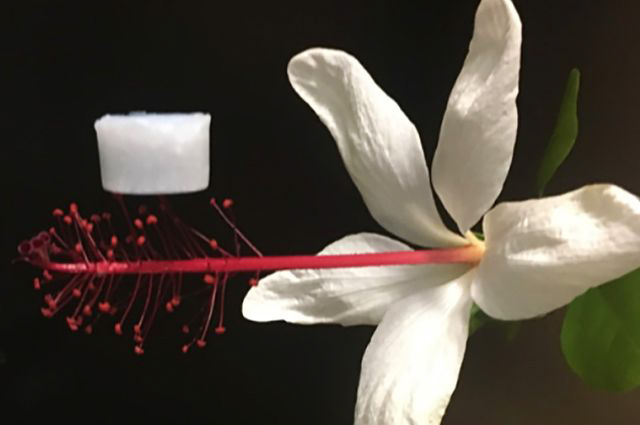UCLA researchers help develop new, more durable aerogel insulator

Current aerogels used in spacecrafts crack under extended exposure to high temperatures, requiring scientists to frequently replace the insulator or abandon the technology altogether. The new aerogel called hBN aerogel that can withstand quick temperature changes. (Courtesy of Xiangfeng Duan and Xiang Xu)

By Shruti Iyer
March 8, 2019 12:37 a.m.
UCLA researchers invented a new aerogel that that can withstand quick temperature changes, offering a better way to insulate spacecrafts traveling to planets with extreme conditions.
On planets like Mars, where the temperature fluctuates drastically between day and night, rovers and equipment sent to space require an insulator to keep temperatures constant. Current aerogels used in spacecrafts crack under extended exposure to high temperatures, requiring scientists to frequently replace the insulator or abandon the technology altogether.
Xiangfeng Duan, a chemistry professor, developed a new aerogel called hBN aerogel that can withstand quick temperature changes, high pressure and extreme heat. He published his invention in the academic journal Science last month.
Duan said the material is much lighter than other insulators and almost as light as water.
Yuan Hu, a graduate student and author on the paper, said the aerogel is one of the lightest aerogels to have been created.
“It’s very, very light. … It can almost float in air,” Hu said. “It’s about one centimeter thick and if you put a 1,000 degree flame underneath you wouldn’t feel the heat on top.
While heat usually makes materials expand, this material contracts when exposed to heat.
“For a typical material, when we compress in one direction, they expand in the other direction,” Duan said. “For this particular structure when you compress in the vertical direction, it contracts in the lateral direction.”
Menglong Hao, an engineering professor from UC Berkeley and an author on the paper, said the durability of the material also makes it a promising material for space insulators and clothing. Even when the insulator is compressed to 5 percent of its original volume, it is still able to spring back into its original shape without significant damage.
Hao said he modeled the hBN aerogel after a similar material called graphene aerogel, which fractures easily and burns at high temperatures.
Tim Fisher, the chair of the mechanical and aerospace engineering department, said the project’s main challenge was finding a better insulator than air, which has been long considered the most effective insulator.
For example, sweaters are designed to provide insulation by using air pockets between wool fibers to keep hot air in and cold air out.
“The (aerogel’s) value of thermal conductivity was lower than the air itself, which is really hard to do,” Fisher said.
Both Hu and Fisher said it was difficult to measure the transfer of heat through the material using traditional tools because it was too thin. They instead used an infrared camera to collect images of heat transferring through the aerogel, which they used to extract data, Fisher said.
Duan said he was surprised by how easily the material was damaged due to contamination while transporting the aerogel between labs.
Fisher said he does not know how the material holds up over time. He added he is worried that contamination could lead to the collapse of the structure in the long run.
Hao said the material could be used in the construction of insulated buildings and other high-end applications. However, he said the material must be produced on a larger scale before it can be used commercially.
Duan added researchers must find a cheaper way of producing the aerogel to make it more accessible to the general public.
“The materials are not exotic,” Fisher said. “Certainly there’s a path to making it economically viable, but it would have to be scaled up and the costs would directly correlate to that.”

